The Best Italy Trip Itineraries For Foodies
For traveling foodies, there’s no better destination than Italy. (Prove me wrong.) I lived in Milan for three years and traveled throughout the country in search of amazing food and wine – and I continue to go back every year with new Italy trip itineraries to uncover new culinary experiences. I’ve written about different destinations within Italy including my favorite winery in Umbria and a great food and olive oil tasting in Capri.
Italy is a dream destination for foodies, offering a culinary journey that spans diverse regions, each with its own unique flavors and specialties. From hearty pasta dishes to delectable pastries, fresh seafood, and world-renowned wines, there’s no better place to indulge your taste buds.
Sign up for the Foodies for Travel newsletter and get a FREE copy of
“The Ultimate Foodie’s Guide to Italy.”
Click here to sign up.
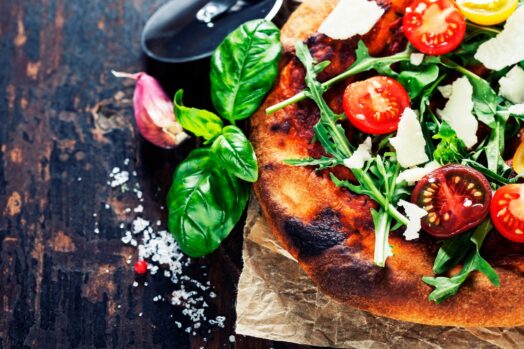
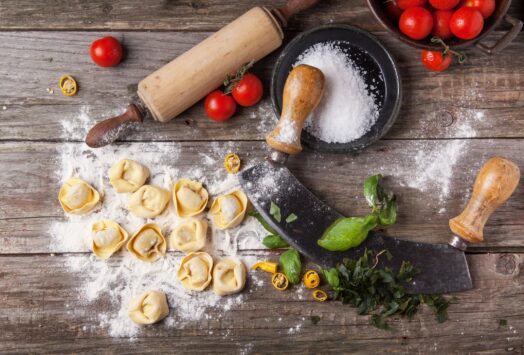
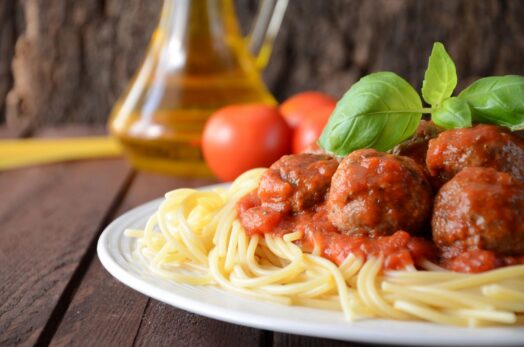
How Regional Foods Vary Across Italy
Italy’s culinary traditions are deeply rooted in its diverse regions, each influenced by local geography, climate, and history. In the north, you’ll find creamy risottos and hearty polenta dishes, reflective of the cooler climate and Alpine terrain. The central regions, like Tuscany and Umbria, are known for their rustic, earthy flavors, featuring olive oil, legumes, and roasted meats. Southern Italy, with its Mediterranean coastline, offers vibrant, tomato-based sauces, fresh seafood, and an abundance of citrus and herbs. Sicily and Sardinia showcase island-inspired dishes with bold flavors, incorporating ingredients like capers, almonds, and saffron. This regional diversity ensures that no matter where you travel in Italy, you’ll encounter a unique and unforgettable culinary experience. Plan your Italy trip itineraries with an option to explore different regions.
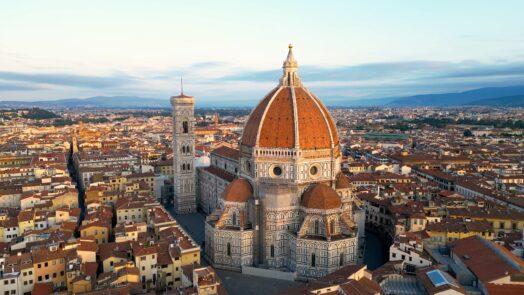
Florence
Florence, the heart of Tuscany, is a paradise for food enthusiasts. The region is famous for its simple yet flavorful dishes that showcase high-quality, locally sourced ingredients. This is the home of my husband’s favorite dish, Bistecca alla Fiorentina, a thick-cut T-bone steak cooked over an open flame and seasoned with just salt, pepper, and olive oil. My all-time favorite soup is Ribollita, a hearty bread and vegetable soup, perfect for cooler evenings (I highly recommend Ina Garten’s recipe). I first had it when I moved to Italy and visited Gubbio. For dessert, Cantucci with Vin Santo is a crunchy almond biscotti dipped in sweet dessert wine. Yummy!
The Best Restaurants in Florence
I always say that you can’t go wrong eating at any restaurant in Italy, but here are a few of my favorites in Florence. Trattoria Mario is rustic eatery serving authentic Tuscan dishes, including one of the city’s best Bistecca alla Fiorentina. Osteria Vini e Vecchi Sapori is a cozy spot offering a rotating menu of local specialties.
Things For Foodies to Do in Florence
There’s no better place for wine tasting than along the famous Chianti Trail. Just a short drive from Florence, the Chianti region offers wine-tasting tours where you can sample renowned Chianti Classico wines. This region also offers a number of cooking classes where you can learn to make handmade pasta or a traditional Tuscan meal at local cooking schools like MaMa Florence. You can also explore the vibrant markets of the town to taste local produce, cheese, and meats.
The Best Hotels in Florence
There are so many great hotels and villas in Florence offering a variety of exceptional hotels that cater to different preferences and budgets.
Four Seasons Hotel Firenze, a 5-star hotel set in a historic 15th-century palazzo, featuring a private park, spa, and Michelin-starred restaurant. Located in central Florence, it offers 116 luxurious rooms and suites adorned with Renaissance art and modern amenities. Guests can enjoy the hotel’s expansive private gardens, a summer swimming pool, and the Michelin-starred Il Palagio restaurant. Room rates start at approximately $1,084 per night.
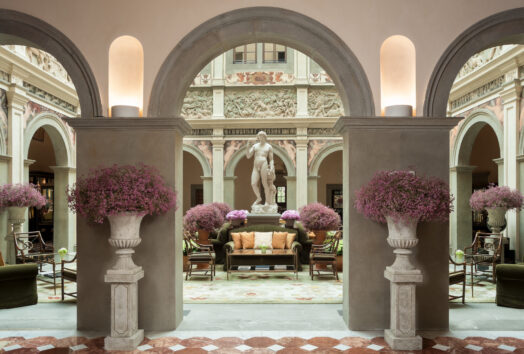
Brunelleschi Hotel is a boutique hotel located in the heart of Florence, just steps from the Duomo. Located in the heart of Florence, it offers 96 elegantly appointed rooms and suites within a restored Byzantine tower and medieval church. Guests can enjoy modern amenities, two on-site restaurants—including the Michelin-starred Santa Elisabetta—and a private museum. Room rates vary depending on the season and availability; for the most accurate and current pricing, it’s recommended to check the hotel’s official website or contact them directly.
Helvetia & Bristol Firenze is a historic 5-star hotel in Florence offering 64 rooms in the Helvetia wing adorned with restored artworks, and 25 rooms in the Bristol wing designed by Anouska Hempel. Guests can enjoy amenities such as a luxurious spa, a restaurant by Cibrèo, and proximity to landmarks like Palazzo Strozzi. Room rates vary depending on the season and availability.
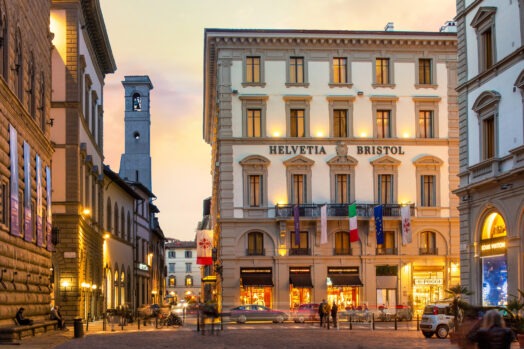
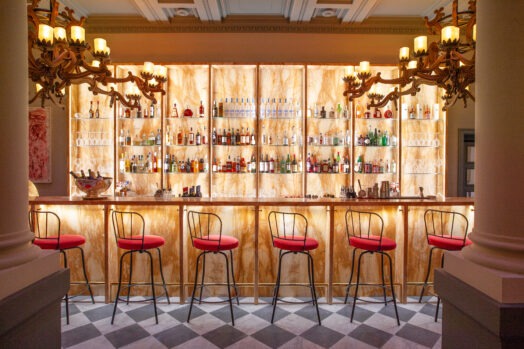

Hotel L’Orologio, located near the Santa Maria Novella train station and within walking distance to many of the city’s top attractions. This 4-star hotel offers stylish rooms, a great location, and good service at reasonable prices, typically starting around $200–$300 per night, depending on the season.
Another option is Hotel Spadai, a centrally located hotel offering contemporary rooms, excellent amenities, and a prime location near the Duomo, with rates typically ranging from $150–$250 per night.
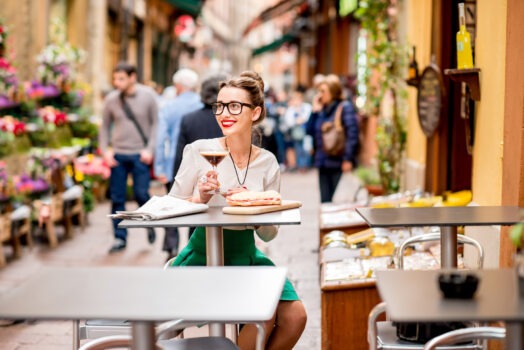
Bologna
Known as “La Grassa” (“The Fat One”), Bologna is a haven for lovers of rich, indulgent cuisine. This is where the classic Tagliatelle al Ragù originated, fresh pasta topped with a slow-cooked meat sauce. Mortadella is what most of us consider as Bologna, but it’s quite different in Italy as a high-quality, flavorful cured meat often served as an antipasto. Tortellini in Brodo can be found on most menus here, small, stuffed pasta served in a delicate broth.
Best Restaurants in Bologna
Osteria dell’Orsa is famous for its traditional pasta dishes, especially tagliatelle al ragù (my personal favorite!). Trattoria da Gianni is a family-run spot offering excellent tortellini and other Bolognese specialties.
Things to do in Bologna
There are many great cooking and pasta-making classes in the region. Learn the art of creating perfect tortellini and tagliatelle with local experts. FICO Eataly World is a food-themed park where you can taste, shop, and learn about Italian food. Be sure to check out the walking food tours and sample local delicacies while discovering the city’s culinary history.
Where to Stay in Bologna
The Grand Hotel Majestic Già Baglioni is the oldest and most prestigious hotel in Bologna, located in the heart of the city on Via dell’Indipendenza, within walking distance of Piazza Maggiore and the famous Due Torri. Housed in an 18th-century palazzo, the hotel features opulent interiors with gleaming marble floors, white Doric columns, and gilded antique furnishings. Guests can enjoy amenities such as a wellness area with a sauna and hammam, as well as a terrace. Room rates at the Grand Hotel Majestic “già Baglioni” typically range from $488 to $649 per night for a standard room.
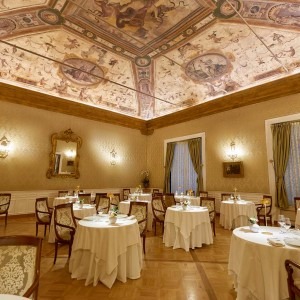

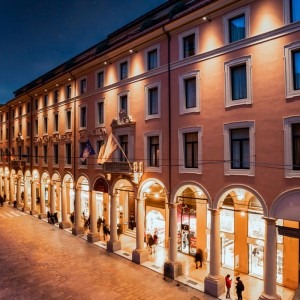
Hotel Corona d’Oro is a luxurious and well-positioned within Bologna’s pedestrianized center, this hotel offers 40 rooms and suites, including some family-sized suites. The decor features classical furnishings, parquet floors, stucco work, and original exposed beams. Guests can enjoy hotel bikes and a chic bar as great extras. Standard room rates typically start around $202 per night, with prices varying based on the season and room type.
I Portici Hotel Bologna is located near the central train station, this hotel offers a blend of historic architecture and modern amenities. Guests appreciate its convenient location and the quality of its services. Each of these hotels provides a unique experience, ensuring a memorable stay in Bologna. I Portici Hotel Bologna offers a range of room types to suit various preferences and budgets. Standard room rates typically start around $101 per night, with prices varying based on the season and room type.
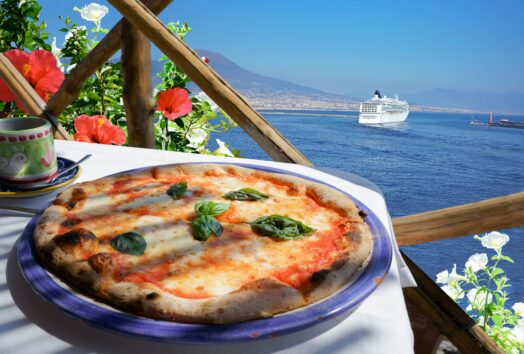
Naples
Say no more! Pizza in Italy is very different from the traditional pizza found in the U.S. Naples is synonymous with pizza, but its culinary offerings go far beyond this iconic dish. This where you absolutely must try the traditional Pizza Margherita, a simple yet perfect combination of tomatoes, mozzarella, and basil. Sfogliatella is shell-shaped pastry filled with sweet ricotta and citrus. Because of it’s location on the coast, Naples is also known for it’s seafood.
The Best Restaurants in Naples
The Naples food scene has really emerged in recent years. L’Antica Pizzeria da Michele is hailed as the best pizza in the world, so you must give it a try. Trattoria Nennella is a lively, traditional eatery offering a range of Neapolitan dishes.
Things to Do in Naples
Obviously, you need to master the art of crafting authentic Neapolitan pizza. There are also a number of street food tours. Explore the bustling streets of Naples and sample fried pizza, arancini, and other treats. You can also visit vineyards on Mount Vesuvius and taste unique volcanic wines paired with local dishes.
Where to Stay in Naples
Naples has come a long way as a tourist destination. It is safer and cleaner, and how has some great hotels. Here are a couple I recommend.
Hotel Il Convento is a charming boutique hotel in the Spanish Quarter with traditional Neapolitan architecture and modern comforts. Standard room rates typically start around $93 per night, with prices varying based on the season and room type.
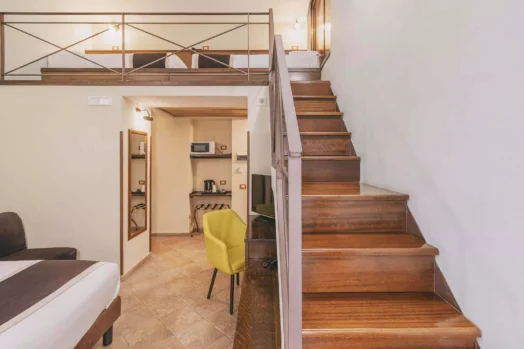

Hotel Piazza Bellini is a stylish hotel in a restored 16th-century building, located in the historic center with a peaceful courtyard. The hotel features 48 rooms and 8 apartments, each uniquely decorated with modern art and local paintings. Guests can enjoy amenities such as a charming courtyard, a library-cum-sitting-room, and complimentary Wi-Fi throughout the property. Standard room rates at Hotel Piazza Bellini start at approximately €162 per night, with prices varying based on the season and room type.
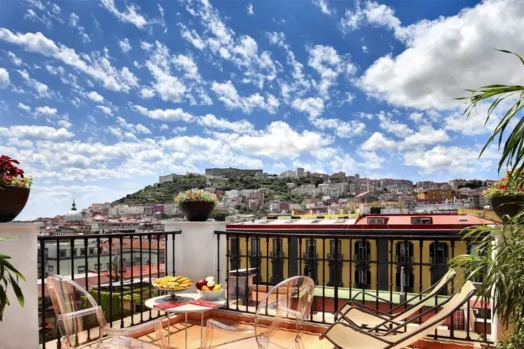
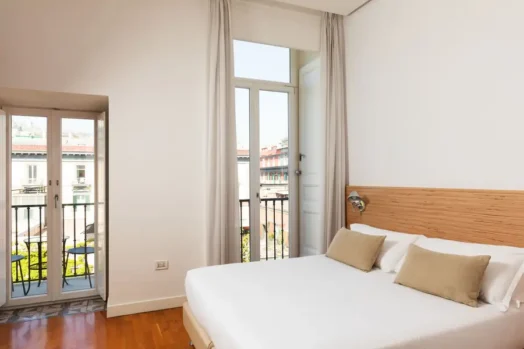

Hotel Correra 241 located in Naples’ historic center, is renowned as the city’s first Art Hotel, seamlessly blending hospitality with contemporary art. Housed in a former factory, the hotel features modern rooms adorned with bold, colorful decor and contemporary artworks. Guests can enjoy amenities such as a rooftop garden terrace offering stunning views of the city. Standard room rates at Hotel Correra 241 start at approximately $65 per night, with prices varying based on the season and room type.

Parma
Parma is best known as the home of Parmesan cheese. It is also celebrated for its high-quality cured meats, making it a must-visit for food aficionados. Parmigiano Reggiano is the king of cheeses, often aged for 24 months or more. Another one of my favorites: Authentic Prosciutto di Parma, delicately sweet, thinly sliced cured ham. Tortelli d’Erbetta is pasta stuffed with ricotta and spinach.
Great Restaurants in Parma
Trattoria Ai Due Platani is renowned for its authentic tortelli and other local dishes. Osteria del Teatro is a sophisticated spot offering an elevated take on Parma’s culinary classics.
Food-Related Activities in Parma
Visit a Parmigiano Reggiano producer to see the cheese-making process and enjoy tastings. Learn how Prosciutto di Parma is crafted and sample this delicacy. Explore the museums dedicated to Parmesan cheese and prosciutto.
Where to Stay in Parma
Grand Hotel de la Ville is is a 5-star hotel situated just steps from the historic city center. Housed in a former pasta factory, the hotel features 110 rooms, including 3 suites and 4 junior suites, blending modern design with historical architecture. Amenities include a conference center accommodating up to 200 people, a restaurant, a cocktail bar, a fitness area, and complimentary Wi-Fi. Standard room rates at the Grand Hotel de la Ville start at approximately €162 per night, with prices varying based on the season and room type.
NH Parma a modern 4-star hotel situated adjacent to Parma’s central train station, offering convenient access to the city’s main attractions. The hotel features 120 contemporary rooms, including Standard Rooms and Junior Suites, all equipped with air conditioning, 42-inch flat-screen TVs, and free Wi-Fi. Guests can enjoy international cuisine and Italian wines at the on-site restaurant, as well as a fitness center and a stylish bar. Standard room rates at NH Parma start at approximately €162 per night, with prices varying based on the season and room type.
Hotel Button is a charming 3-star hotel situated in the heart of Parma’s historic and commercial center, near Piazza Garibaldi. Housed in a 19th-century building, the hotel offers a range of services to ensure a comfortable and relaxing stay for its guests. Standard room rates at Hotel Button start at approximately €65 per night, with prices varying based on the season and room type.
How to Know You’re Buying Real Parmesan Cheese From Parma
Authentic Parmigiano Reggiano is strictly regulated and carries specific markings to ensure its authenticity. Look for the Parmigiano Reggiano Consortium stamp on the rind, which includes the dotted lettering, the producer’s code, and the date of production. Cheese aged for over 12 months will also have a certification seal. When purchasing in the U.S., ensure the packaging indicates “DOP” (Denominazione di Origine Protetta), confirming it was produced in the designated region of Parma, Reggio Emilia, Modena, or parts of Mantua and Bologna. Additionally, authentic Parmigiano Reggiano will often be sold in chunks with the rind still attached—avoid pre-grated varieties that may not meet these standards.
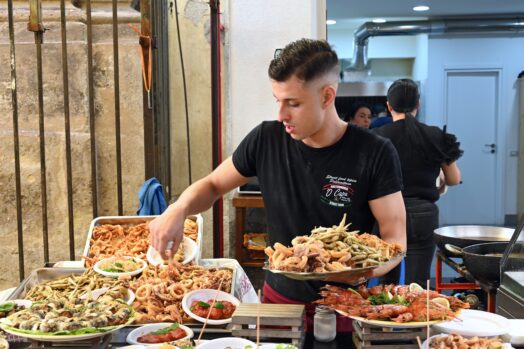
Palermo
My husband’s family is from Sicily and the food in this part of Italy is quite different. The capital of Sicily, Palermo offers a vibrant and diverse food scene influenced by a mix of cultures. There is nothing better than a classic Arancini, fried rice balls stuffed with ragu, mozzarella, and peas. A favorite dessert, Cannoli (or cannolo for one) hails from Sicily. Thanks to its location on sea, Sicily is also famous for its seafood. Pasta con le Sarde is served with fresh sardines, fennel, raisins, and pine nuts.
The Best Restaurants in Sicily
Osteria Ballarò is a charming restaurant serving classic Sicilian dishes. Antica Focacceria San Francesco is a historic spot offering authentic street food.
The Best Activities in Sicily for Foodies
Take a street food tour and discover Palermo’s vibrant markets and try arancini, panelle, and sfincione. Sign up for a cooking class and learn to prepare Sicilian specialties like caponata and cassata. Sample bold Nero d’Avola and other Sicilian wines.
Where to Stay in Sicily
Hotel Casena dei Colli is a 3-star hotel offering comfortable rooms with free Wi-Fi, set in a peaceful area surrounded by greenery, yet close to the city center. Hotel Casena Dei Colli in Palermo, Sicily, offers rooms starting at approximately $44 per night in February 2025
Hotel Tonic is located in the heart of Palermo, this hotel provides easy access to major attractions including Teatro Massimo and Politeama Garibaldi Theater and offers spacious rooms at reasonable rates. a 3-star property in Palermo, Sicily, offers rooms starting at approximately $63 per night for two adults in February 2025.
Hotel Columbia Palermo is a budget-friendly hotel situated near the historic center, offering clean accommodations and friendly service. The hotel is centrally located in the Monte di Pietà district, within walking distance of attractions like the Quattro Canti and Massimo Theater. Hotel Columbia offers rooms starting at approximately $54 per night.
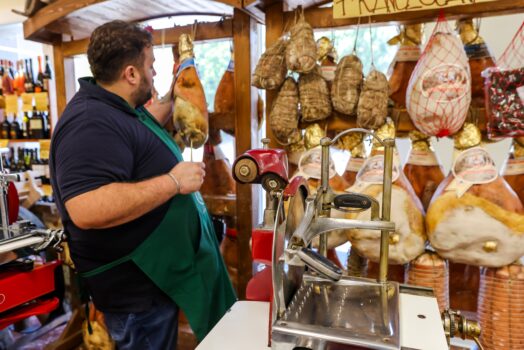
Modena
Modena is not as well known of a city in Italy but one of it’s most famous food products is. It is a charming city in Emilia-Romagna, is renowned for its world-class balsamic vinegar and culinary innovation. Aceto Balsamico (Balsamic vinegar) can be aged for decades and can be quite pricey. Gnocco Fritto is fried dough puffs often served with cured meats.
Best Restaurants in Modena
Osteria Francescana is a three-Michelin-starred restaurant and a culinary mecca for food enthusiasts. Trattoria Aldina is a beloved local spot offering traditional Modenese dishes.
Things to do in Modena
Take a tasty balsamic vinegar tours and visit acetaia (vinegar producers) to learn about and taste this prized condiment. Explore Mercato Albinelli for fresh produce and regional delights. Combine visits to iconic car factories with tastings of local delicacies.
Where to Stay in Modena
Hotel Rua Frati 48 in San Francesco is a luxurious 5-star boutique hotel housed in a Renaissance-era building in Modena’s historic center. It seamlessly blends contemporary furnishings with period features and offers amenities like a wellness area and refined dining options.
Phi Hotel Canalgrande is set in a historic building, this hotel boasts elegant interiors and a serene garden. Its central location provides easy access to Modena’s main attractions, making it a favorite among travelers seeking both comfort and convenience.
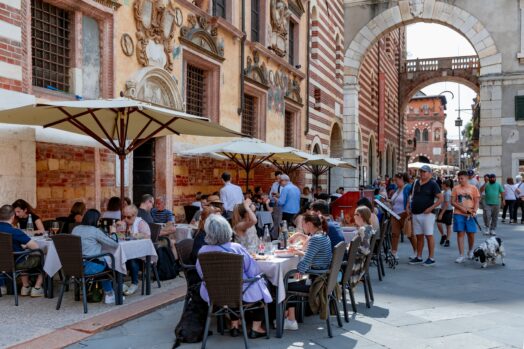
Verona
Known for its Shakespearean history, Verona also boasts a rich culinary heritage, particularly its love for risotto. Risotto all’Amarone is made with Amarone wine for a rich, velvety flavor. You can also find vegetable risotto on many menus. Pandoro, or panettone, is a sweet, star-shaped cake typically enjoyed during the holidays.
Must-try Restaurants in Verona
Antica Bottega del Vino is a historic wine bar offering excellent risottos and a vast wine selection. Ristorante 12 Apostoli is a refined dining experience with a focus on Veronese specialties.
Things to Do in Verona
Go wine tasting in Valpolicella and discover Amarone and other renowned wines in nearby vineyards. Take a cooking class and learn to prepare risotto and traditional Veronese dishes. Combine culinary exploration with visits to Verona’s historical landmarks.
Where to Stay in Verona
Hotel Bologna is a boutique hotel is located in the heart of Verona, a few minutes away from the city’s historical monuments, facing the beautiful Piazza Brà. Elegant, newly renovated guestrooms are colour-themed on each floor of the hotel. Head down to the restaurant to sample Venetian specialities. Hotel rats start at $97 per night.
Hotel Milano & Spa is situated just 100 meters from the iconic Arena di Verona and offers modern accommodations with a rooftop terrace boasting panoramic city views and a hot tub. Guests appreciate its central location, contemporary rooms, and the added luxury of an on-site spa. Rates start at approximately $103 per night.
How to Get to These Cities from Milan or Rome
Traveling through Italy is an adventure in itself, and getting to these foodie destinations is easy and enjoyable. The high-speed train is always a great option but you can certainly also rent a car as the interstates are fine.
From Milan:
- Florence: Take a high-speed train from Milan’s Centrale Station to Florence’s Santa Maria Novella Station. The journey takes about 2 hours.
- Bologna: Hop on a high-speed train from Milan to Bologna. The trip is just over an hour.
- Naples: A high-speed train from Milan to Naples takes approximately 4.5 hours.
- Parma: Reach Parma in about 1.5 hours by regional train from Milan.
- Palermo: Fly from Milan to Palermo in about 1.5 hours or take an overnight ferry.
From Rome:
- Florence: A high-speed train from Rome’s Termini Station gets you to Florence in 1.5 hours.
- Bologna: Travel from Rome to Bologna by high-speed train in just over 2 hours.
- Naples: A quick 1-hour journey by high-speed train from Rome.
- Parma: Reach Parma from Rome by high-speed train in around 3.5 hours.
- Palermo: Fly from Rome to Palermo in about 1 hour or take an overnight ferry.
Tips for Traveling Throughout Italy
- Book Tickets in Advance: High-speed trains and flights often offer discounts for early bookings.
- Travel Light: Navigating train stations and cobblestone streets is easier with minimal luggage.
- Use Regional Transport: Regional trains and buses are a budget-friendly option for shorter distances.
- Consider Renting a Car: For destinations like Chianti and rural Parma, a car offers the flexibility to explore at your own pace.
Italy’s culinary landscape is as rich and diverse as its history. Whether you’re savoring a perfectly baked pizza in Naples or sampling fresh Parmigiano Reggiano in Parma, every bite tells a story. With this guide, you’re well-equipped to embark on a gastronomic journey that will delight your senses and leave you craving more.
Sign up for the Foodies for Travel newsletter and get a FREE copy of
“The Ultimate Foodie’s Guide to Italy.”
Click here to sign up.
This blog post may contain affiliate links, meaning that if you click on a link and make a purchase, I may receive a small commission at no extra cost to you. I only recommend products and services I truly believe in and use myself.

